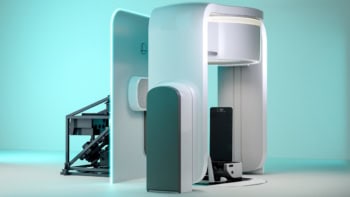
Researchers in the UK have invented a new way of boosting the sensitivity of nuclear magnetic resonance (NMR) measurements by a factor of 1000. The technique involves mixing molecules of interest with a “spin isomer” of hydrogen and a metal hydride, which forces the nuclear spins of the sample into a specific energy state. This makes the molecules much more visible to NMR measurements as well as magnetic resonance imaging (MRI), which uses NMR to map different tissue types within the body.
According to the researchers, led by Simon Duckett and Gary Green from the University of York, molecules that have been treated in this way could someday be injected into the body, reducing the time to take an MRI image from hours to a fraction of a second. This, they say, could allow medical researchers to watch how a patient responds in real time to drug therapy. It could also allow larger and more detailed scans to be made — allowing doctors to see tumours earlier than possible today (Science 323 1708).
NMR measurements are made by exposing a sample to a very high magnetic field, which aligns the magnetic moments of its nuclei in a specific direction. The magnetic energy levels are quantized, and the spacing between the levels — as well as the time it takes for transitions between those levels — can be measured by applying a radio-frequency signal to cause a transition and then measuring the radio signals that are given off as the magnetic moments return to equilibrium. This provides a wealth of information about the chemical and structural composition of the sample.
Few molecules take part
The problem with NMR is that the energy levels of interest in a sample at room temperature are almost equally populated. Only a very small fraction of molecules in a sample — fewer than one in 30,000 — therefore contribute to the NMR signal. Some researchers have tried to get round this problem using various “hyperpolarization” techniques that involve transferring spin to molecules of interest to ensure that most of the molecules are in one specific nuclear spin state.
Unfortunately, some of these techniques involve long sample preparation times while others involve altering the target molecules in chemical reactions – neither of which are appropriate for medical scans. What Duckett’s team has done is to work out a way of transferring spin from “parahydrogen” — a spin isomer of the hydrogen molecule with no overall magnetic moment — to the organic molecule pyridine C5H5N.
The technique involves mixing the pyridine with parahydrogen and iridium dihydride. Parahydrogen and iridium dihydride molecules first pair-up to create a metal complex that is in a specific spin magnetic state. This complex then attaches itself to a pyridine molecule, and again the entire structure is in a specific spin magnetic state. The structure then breaks up into the three original constituents — leaving the pyridine in the desired spin magnetic state.
Good news for chemists
Duckett told physicsworld.com that by doing this the team were able to boost the proton, carbon and nitrogen NMR signals from pyridine by a factor of 1350 over untreated samples. Similar results were also achieved with the compound nicotinamide and Duckett says that the technique could be applied to other molecules. This improvement could be great news for chemists as it would boost the performance of high-resolution NMR.
Another advantage is that the technique can be used without modifying MRI equipment, which means that the technique could be easily implemented on scanners currently used in hospitals. Moreover, molecules prepared in this way would stand out in a scan relative to identical molecules that had not been treated, allowing the treated molecules to be tracked as they move through the body.
The team have applied for a patent on the method and Green says that they are “exploring commercial options”.



